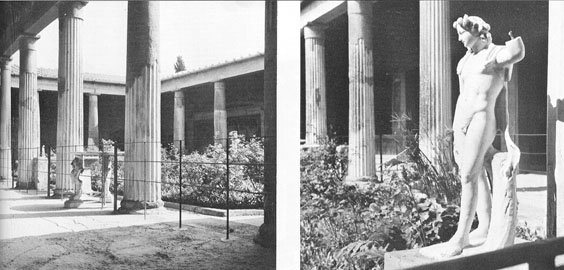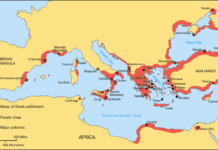The Classical Greek house was built around particular ideals, but these are sometimes sacrificed for the realities of society.
Introduction
The type of house which the majority of Greek citizens in the Classical period lived in is known as the courtyard house. It consists of a courtyard, walled on all sides and open to the sky, with rooms opening onto it. Generally there is a gate or even a porch to access the courtyard from outside. At some rural houses, such as the Dema House in Attica, there was a tower on one corner (Jones et al. 1962). It is likely that most houses had separate men’s and women’s quarters, to keep wives and daughters hidden from view, and prevent female slaves from becoming pregnant.
Ideals
It has been argued that the courtyard layout developed alongside social changes, which meant that there were new attitudes towards what it meant to be a citizen. The development of this type of house coincided with an increase in formal burials, which Westgate suggests may be as a result of changes in social attitudes leading to power becoming more equally shared among a citizen group rather than merely the very wealthy (Westgate 2007, 234). While archaic houses, the precursors to the courtyard house, generally consisted of one or more room with outside space in front, visible to anyone who happened to walk past, the courtyard house is far more private, with the courtyard protected by high walls and accessible only through a gate or entrance room.
The courtyard house effectively separated public and private life: within, the householder was king of his domain, ruler of his household. Outside, he was on equal footing with his fellow citizens as a result of this (Westgate 2007, 240) – he had the same control over his family as every other citizen, even if there was a gap in wealth.
Realities
The ideal of each citizen being equal is most evident at Olynthus. A city in Chalchidice in northern Greece, Classical Olynthus was highly planned. Residences were built on a grid plan like many modern cities. Each house was roughly square, and equal in size to the other houses – when they were built. But this situation did not last. Over time, as some citizens gained wealth and others lost it, changes were made to their houses. Rooms were transfered from one house to another by blocking up the doorway and creating a new one into the adjacent house (Cahill 2000, 500-501).
The site of Olynthus is fairly flat, suitable for building equal houses. At other sites the ideal of the equal house is less practical. Thorikos in Attica, Greece, was a town in the silver-rich and mountainous Laurion region (Mussche 1998, 1). It was well placed to control trading routes and oversee anchorages, but the site is far from flat. Built on the side of a steep hill, known as the Velatouri (Watchtower), the residents had to account for the uneven landscape when building their houses. A number of houses have been excavated there; many had rooms on different levels to account for the slope they were built on – the houses at Thorikos had to fit into the landscape, they couldn’t make the landscape fit the ideology.
House 1, in its first phase, was considerably larger than other houses (Mussche 1998, 14). House 1’s third phase saw it split into two different houses, each with a separate entrance and courtyard, but one of the two new residences was considerably larger than the other – demonstrating inequality in wealth and perhaps status between the citizens who owned each part.
However, both sections of this house in Thorikos, dispite being different in size, still adhere to the courtyard layout. Thus they still adhere to the ideology whereby the citizen head of household has complete control within his very private house. The model of equality falls down as far as wealth is concerned, but it isn’t about just wealth, it’s about status and political autonomy. So while the plans for houses at Olynthus and Thorikos are vastly different – the one square and uniform, the other irregular and shaped to fit the difficult landscape – both still demonstrate the ideology of the courtyard house.








